
Dear Colleagues,
I am very honored to write my first message for Greenlines as the new Chair of the INTOSAI WGEA. The National Audit Office of Finland is very committed to contributing our best efforts to those of a wise and vibrant community. Working together, we seek to provide a good platform for WGEA and to enhance innovative environmental auditing for a common sustainable future.
During the 19th Assembly meeting in Bangkok in August 2019, WGEA adopted a new Work Plan for 2020-2022. We will focus our work on selected topics: plastic waste, climate finance, and sustainable transport. We will connect this work to the sustainable development goals (SDGs) and contribute to the follow-up and …
Read More...By Mushtaq Ahmed Memon, Ph.D.
Many countries have seen impressive economic growth over the last few decades. On the flip side, they have witnessed increasing levels of pollution and depletion of natural resources.
Huge volumes of gaseous, liquid, and …
Read More...
Do you have comments on this issue of Greenlines? Click here to send us an e-mail.
Read about your fellow auditors' work on environmental issues

Dear Colleagues,
I am very honored to write my first message for Greenlines as the new Chair of the INTOSAI WGEA. The National Audit Office of Finland is very committed to contributing our best efforts to those of a wise and vibrant community. Working together, we seek to provide a good platform for WGEA and to enhance innovative environmental auditing for a common sustainable future.
During the 19th Assembly meeting in Bangkok in August 2019, WGEA adopted a new Work Plan for 2020-2022. We will focus our work on selected topics: plastic waste, climate finance, and sustainable transport. We will connect this work to the sustainable development goals (SDGs) and contribute to the follow-up and review process of SDGs at the INTOSAI level. Thus, we aim to keep the environmental foundation of SDGs, the “Rio Process,” alive in the INTOSAI community.
The Work Plan pays particular attention to the visibility of our work and to enhancing communication internally and with external stakeholders. The objective is to keep past work alive, including all projects the Assembly adopted in August. Hereby, I warmly welcome all WGEA members to continue the good work. Working together gives us strength and wisdom in addressing global challenges.
I would like warmly thank SAI Indonesia for the successful 6-year chairmanship of this important working group. I acknowledge the precious and coherent work done by all previous Chairs. Standing on the shoulders of giants, we see further.
Tytti Yli-Viikari
Chairman
Auditor General, SAI Finland
By Mushtaq Ahmed Memon, Ph.D.
Many countries have seen impressive economic growth over the last few decades. On the flip side, they have witnessed increasing levels of pollution and depletion of natural resources.
Huge volumes of gaseous, liquid, and solid emissions, discharges, and disposals are generated in the value chain.
This pollution is further contaminating already depleting natural resources and creating serious impacts on public health and life on earth, including in the sea. Pollution is largely controllable and avoidable. However, it is increasing at an unprecedented rate, and increasing volumes of hazardous substances will make it more difficult to control at later stages. The transboundary movement of pollutants is also a major environmental, economic, and political challenge.
Plastics are among the key pollutants in the ecosystem, mainly due to mismanaged waste plastics, and are rapidly becoming a serious issue. Over the past 65 years, annual production of plastics increased nearly 200-fold, to 381 million tons in 2015, equivalent to the mass of two-thirds of the global population (ourworldindata.org/plasticpollution).
We can move from this vicious cycle to a virtuous cycle, in which economic growth, jobs, improvements in public health, reduced poverty, and gender equality are linked with more sustainable management of pollution and environmental resources. A shift is needed to develop a more coherent and comprehensive set of crosssectoral policy frameworks. Such policies will also need to align with prerequisites such as green technologies, financing mechanisms, and stakeholder engagement. strengthened and reformulated, and enforcement capacity can be enhanced by providing political and technical domestic support and through international cooperation.
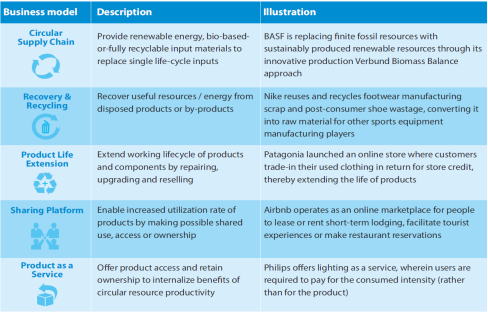
The above table describes an example of a circular economy model developed for India by the Federation of Indian Chamber of Commerce and Industry (FICCI).
The Forum of Ministers and Environment Authorities of Asia Pacific can provide a platform to discuss and launch initiatives to boost domestic support and strengthen international cooperation. This will facilitate greater alignment among members to achieve the targets under the various Sustainable Development Goals (SDGs), the 2030 Development Agenda, and the Nationally Determined Contributions (NDCs) under the Paris Agreement.
A circular economy approach based on life-cycle approaches helps connect the extraction of materials and production of goods to consumption and waste management. Such a circular economy approach focuses on plastics management in its context to increase resource efficiency and reduce pollution throughout the lifecycle of plastics.
The lifecycle approach is the basis for developing this circular economy model, and lifecycle costing is key to detailing out each segment of the circular economy. Hence, the components for a circular economy may include circular supply chains, recovery and recycling, product life extension, sharing platform or shared economy as a subset of the circular economy, and product as a service. The above table shows an example of a circular economy model suggested for India by the Federation of Indian Chamber of Commerce and Industry (FICCI) (http://ficci.in/spdocument/ 22977/FICCI-Circular-Economy.pdf).
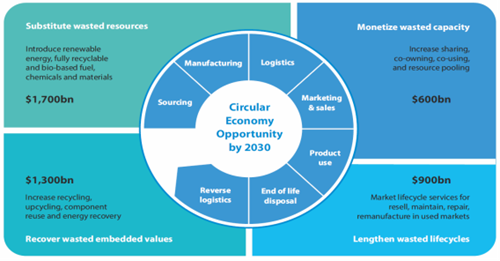
This figure provides an example from the Federation of Indian Chamber of Commerce and Industry (FICCI) for the country of India, on how circular economy can help reduce waste plastics and their corresponding effects on human health and the environment.
To operationalize a circular economy, the model may also contain information on various stages and stakeholders involved. This can be further consolidated with estimated benefits to understand priority stages and stakeholders.
The following discussion is an example from the FICCI report for India. Waste plastics trade is increasing rapidly with severe negative environmental impacts at points of origin, on high seas, at transit points, and at the receiving and recycling point.
There are various efforts by international agencies, countries where the waste plastics trade originates, maritime agencies and shipping lines, and countries where waste plastics are being received and recycled.
A holistic and integrated approach is required for efficient and effective roles by various stakeholders across the full value chain of illegal trade in waste plastics. These stakeholders are categorized as follows:
These stakeholders are interlinked due to the following aspects of illegal trade in waste plastics:
Keeping these aspects in mind, the following areas could be improved for relevant stakeholders involved:
Goal of plastics pollution-free planet can unite member states
Moving towards a plastics pollution-free planet is an aspirational goal for governments and stakeholders. This goal can unite member states because pollution affects all humans beyond geographical borders. Therefore, connecting economic growth with pollution control and environmental improvement is the key to achieving this goal.
This goal seeks to consolidate partnerships among and between public and civil society entities and include the private sector even further with a view to strengthening synergies and bringing all networks together for greater collective impact in the region and beyond. It also responds to the need for enhanced regional partnerships to support the implementation of SDGs. In this regard, the Ministerial Forum will seek to reinforce regional efforts and create a platform to mobilize and share knowledge, expertise, technology, and financial resources to support the initiatives in all countries of the region.
Targeted interventions can be based on both global and regional environmental agreements or directed action beyond these to address the most pressing challenges in transforming cities, countries, and the region to be plastics pollution-free. These interventions and transformative actions can be supported by system-wide enablers to ensure long-term positive impacts leading to achievement of SDGs and other environmental targets across the globe.
Dr. Mushtaq Ahmed Memon works as Regional Coordinator for Resource Efficiency at the UNEP Regional Office for Asia and Pacific. This article is written in a personal technical capacity, and the views expressed do not reflect the organization’s views.
The 19th INTOSAI WGEA Assembly meeting took place August 6 through 9, 2019, in Bangkok, Thailand. The meeting served as forum to exchange knowledge and experiences on current environmental issues and Sustainable Development Goals (SDGs).
Attendees included 117 participants from 57 Supreme Audit Institutions (SAIs) and international organizations such as the Canadian Audit and Accountability Foundation (CCAF), U.N. Department of Economic and Social Affairs (UNDESA), U.N. Environment Programme (UNEP), Association of Chartered Certified Accountants (ACCA), and U.N. Project Office on Governance (UNPOG).
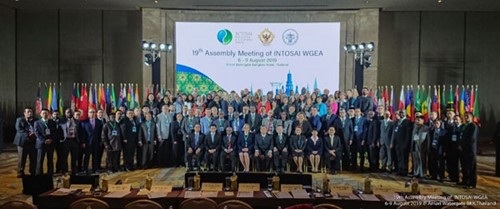
Attendees of the 19th INTOSAI WGEA Assembly Meeting included 117 participants from 57 SAIs.
Before the assembly meeting, a one-day training on greening SAIs focused on how to start possible greening activities at the office, and the easiest and more common activities to reduce the environmental impact of office-based institutions (e.g., related to waste and water management, use of consumables and paper, energy, and transport). The training also addressed SAIs’ management- and performance-related measures to reduce the negative impact of their own activities and provided good practices and tips. This training was a pilot of a WGEA project on the development of training tools on greening SAIs. The European Court of Auditors (ECA) and SAI Estonia as the project leader delivered the training, which 30 participants attended.
The Assembly Meeting kicked off with an excursion to Rayon Province to visit PTT Global Chemical.
On the second day, the meeting started with the opening ceremony, during which the President of the State Audit Commission, State Audit Office of the Kingdom of Thailand; Deputy Secretary-General to the Prime Minister for Political Affairs; and Chairman of the Audit Board of the Republic of Indonesia, Chair of INTOSAI WGEA, delivered their speeches.
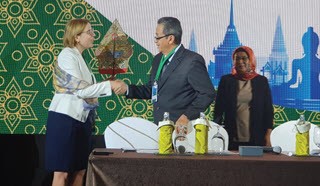
Dr. Moermahadi Soerja Djanegara, Chairman of the Audit Board of the Republic of Indonesia and Chair of INTOSAI WGEA, shakes hands with incoming Chair Ms. Tytti Yli-Viikari, Auditor General of SAI of Finland.
Greenlines Newsletter
At the first plenary session, three speakers - from the United Nations Economic and Social Commission for Asia and the Pacific (UN ESCAP), the Deputy Secretary-General to the Prime Minister for Political Affairs, and ACCA - shared their experiences on current progress in implementing the SDGs.
The second plenary session focused on the role of IT in accelerating the SDGs. A speaker from UNPOG presented her experiences on SDGs and IT for Public Administration. Two other speakers, from SAIs China and Indonesia, shared their experiences in SDGs, "big data" and the use of IT to support auditing of SDGs. Project leaders also provided presentations on their final output.
On the third day, the meeting started with presentations on upcoming WGEA projects. The Regional Coordinator for Resource Efficiency for UNEP's Asia Pacific Regional Office spoke about SDG 12 and plastic waste. The Chairman of the Board of Railway Engineering presented on SDG 11 and sustainable transport.
Participants then joined three breakout sessions to discuss in more detail each SDG discussed at the plenary session. The breakout sessions aimed to foster discussion and brainstorming of projects or programmes for the next WGEA work plan.
The final day of the meeting began with presentations of regional WGEA progress reports. Representatives from each of the regional working groups - ACAG/PASAI WGEA, EUROSAI WGEA, AFROSAI WGEA, ASOSAI WGEA, COMTEMA (OLACEFS), and ARABOSAI WGEA - presented their activities. Next was a session on "Cooperative Audits and SDGs." Presenters from SAIs Thailand, Cyprus and Malta, Poland, AFROSAI —E, and Bangladesh shared their experiences with cooperative audits and SDGs.
Afterwards, a symbolic transfer was held in which the Chairman of SAI Indonesia passed the WGEA leadership baton to the Auditor General of Finland. The formal transfer will be conducted at the INCOSAI XXIII in Russia.
Afterwards, a session was held on WGEA Trainings and the Greenlines newsletter. In this session, presenters reported on the various trainings conducted by INTOSAI WGEA, such as GTF in India and International Training on Forestry in Indonesia, and the Greenlines newsletter.
Some key outcomes from the meeting are as follows:
Finally, the Director General of BPK Training Institute, SAI Indonesia, as Chair of INTOSAI WGEA, officially closed the Assembly Meeting.
Dr. Mushtaq Ahmed Memon works as Regional Coordinator for Resource Efficiency at the UNEP Regional Office for Asia and Pacific. This article is written in a personal technical capacity, and the views expressed do not reflect the organization's views.
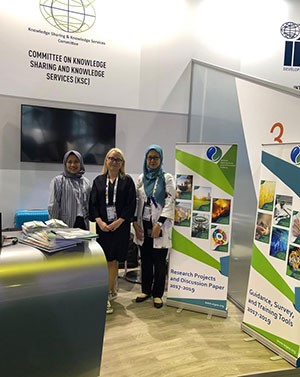
During INCOSAI XXIII, from September 25 through 27, 2019, in Moscow, Russia, the Secretariat of INTOSAI WGEA opened a booth that displayed WGEA products in cooperation with SAI of Finland as the next Chair of the WGEA.
The booth aimed to disseminate WGEA products to the INTOSAI community to raise awareness about what WGEA members have accomplished thus far.
The booth also provided flyers about the WGEA Work Plan 2020-2022 to provide information for SAIs on what WGEA plans to do in the next 3 years and call for the SAIs' participation.During the 2017-2019 Work Plan, WGEA completed five research papers, two guidance documents, one updated guidance on biodiversity, one discussion paper, and three training tools. WGEA members approved these projects during WGEA's 19th Assembly Meeting in Bangkok, Thailand, and they were approved by the INTOSAI Governing Board at XXIII INCOSAI.
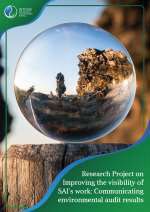
Supreme Audit Institutions (SAIs), as external auditors, hold their governments accountable for public spending. An essential part of this task is to make their audit reports available to parliament, stakeholders, and the general public. Enhancing the visibility of its audits ensures that an SAI's message is heard and contributes to the transparency and accountability of the use of public-sector funds.
This research paper explores who communicates on behalf of SAIs, with whom SAIs communicate, what SAIs communicate, what tends to attract public interest, how SAIs communicate, and how SAIs can measure the visibility of audits. The report identifies trends in SAIs' communication and provides examples of communication strategies, practices, and high-visibility environmental audits from SAIs around the world.
This paper recommends that SAIs have a communication strategy and plan early in the audit process. A well-prepared media strategy and proper communication planning make it easier to communicate to parliaments and the public and, thus, fulfil the SAIs' role in enhancing accountability and transparency.
The most important trend in recent years has been the growing importance of social media and the possibilities and challenges it poses. In addition, SAIs increasingly regard the entire staff as a communication resource. Another development is the growing importance of visual journalism, particularly in digital media. While keeping abreast of these developments, this paper advises SAIs to ensure they maintain the quality of all their products across various media channels and formats.
This paper acknowledges that media attention should not be the sole guiding principle in assessing the importance of an audit, as there are topics that never receive broader public interest but are still essential to government accountability. Nevertheless, this project found that environmental audits tend to receive a lot of publicity because people are interested in and care about environmental issues.
The project was led by the European Court of Auditors (ECA) with support from the project team: the SAIs of New Zealand, Russia, and the United States.
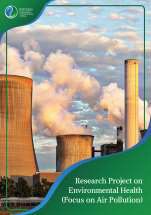
In the 2030 Sustainable Development Goals (SDGs), air quality and its impact on human health was considered one of the top priorities under Goals 3 and 11. These two goals envision making cities and human settlements inclusive, safe, resilient, and sustainable by reducing the adverse per capita environmental impact of cities. This includes paying special attention to air quality and municipal and other waste management as well as ensuring healthy lives and promoting wellbeing for all ages through substantial reduction of the number of deaths and illnesses from hazardous chemicals and air pollution and contamination, among others.
The issues and challenges of air pollution and its health effects showed the need for SAIs to consider this area as an audit priority. Thus, it is essential for SAIs to adopt and implement an effective framework for auditing air pollution and its health effects. This research project aims to assist SAIs in reviewing and evaluating government policies in this area by providing wide-ranging and comprehensive data and information. It likewise intends to provide information regarding air pollution and its health effects through case studies and audits conducted by SAIs on this topic.
The work on this document was led by the SAI of Philippines with contributions made by SAIs worldwide, including project subcommittee members Morocco, Czech Republic, Egypt, Iran, and Pakistan.
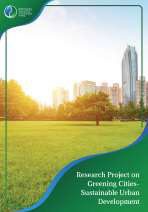
This report seeks to map and describe the most serious environmental problems of urban areas, describe the experience of audit institutions in this area, and emphasize the importance of the topic for INTOSAI WGEA in future years. The study also provides basic information to support the analytical and audit activities of SAIs.
The paper shows the importance of local governments as prime actors in defining local environmental and development policies. In addition, the ICLEI network associates towns, cities, and regions to support green economy and smart infrastructure. To measure the sustainability of cities, many types of indicators have been established.
Based on a questionnaire and on an overall assessment of the "Greening Cities" concept, the study determined that SAIs are concerned with environmental audits. Among other things, due to the implementation of SDGs' national targets, the next challenge will be to evaluate and perform audits of selected environmental components in cities and urban agglomerations. SAIs' basic role remains at the national system level because governments set rules through legislation, strategies, programs, and specific tools and measures.
This project was led by the SAI of Czech Republic and supported by subcommittee members from the SAIs of China, Indonesia, Morocco, Philippines, Slovakia, and the United States.
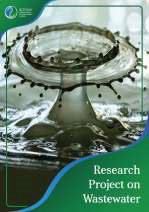
The objectives of this research paper are to
There are a number of opportunities for reusing wastewater as a resource. Properly treated, wastewater can act as a source of irrigation and fertilization for agriculture, affordable water for urban and industry uses, and energy. The discharge of untreated wastewater into the natural environment can have negative, sometimes irreparable, effects on the ecological system, human health, and economic activities. For these reasons, public decision-makers have to carry out policies and measures that allow, on the one hand, the mitigation of the risks generated by wastewater, and on the other hand, the creation of an enabling environment for maximizing the potential of wastewater as a valuable and sustainable resource.
An analysis of the various audit reports of the SAIs that responded to the questionnaire and a summary of the reports extracted from the WGEA website show that the audits touch a wide variety of topics. These topics can be broadly categorized into five major topics:
SAI of Morocco led the work on this document with contributions made by SAIs worldwide, especially project subcommittee members Chad, China, Czech Republic, Iraq, Lesotho, Malaysia, Nigeria, Philippines, Sri Lanka, and the United States.
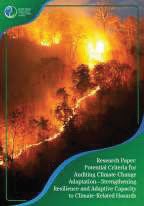
The areas of audit related to climate change and sustainable development goals are relatively new. This document provides readers a first step in an emerging area and provides opportunities for further exploration in future WGEA Work Plans.
The SAI of the United States led this project with support from subcommittee members the SAIs of Canada, Malaysia, New Zealand, and Zambia.
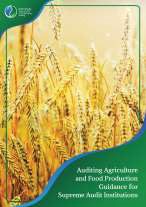
Sustainable agriculture is the foundation for supporting SDGs. Sustainable agricultural development should manage and conserve the natural resource base while meeting the current and future needs of the global population. However, the growing population puts additional pressures on our natural resources because of the need to produce more food. The model of drivers, pressures, states, impact, and response illustrates how global phenomena such as population growth, urbanization, and industrialization through changed patterns of consumption and increased consumption leads to land use change, water degradation, and soil erosion, which, through unsustainable practices, can have severe impacts on biodiversity and ecosystems, as well as increase greenhouse gas emissions.
To be able to do this well, governments need to understand and adapt agricultural policy and measures according to country characteristics such as climate, geography, macroeconomics and demographics, as well as make sure policies respond to the specifics of the food production value chain.
SAIs can audit these agricultural development policies by following the same logic chain, understanding the context and foundations for agriculture and food production in the country, as a first step. Following the four-step approach, by understanding the drivers and threats of the agricultural sector and then mapping the government's approach, the SAI will be able to assess the risks related to the government response and implementation of policies and thus select and prioritize audit topics relevant for their respective countries. A solid selection of topics should be the SAI's starting point for designing audits, in order to assess economy, efficiency and effectiveness of agricultural policies.
The work to develop this guidance was led by the AFROSAI WGEA Secretariat, led and hosted by the SAI of Cameroon in cooperation with project subcommittee members the SAIs of Botswana, Chad, China, Ecuador, Malaysia, Niger, Togo, and the United States.
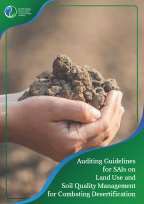
The phenomenon of desertification becomes evident when a comparatively dry land loses its water contents and vegetation and is converted to an arid zone. Land performs multiple functions to sustain humans on earth. The interaction among land resources is vital for determining the productivity and sustainability of agro-ecosystems.
Deforestation, soil erosion, clearing land for construction, and demographic and biological pressures are among the main causes of land degradation and desertification.
Combating desertification is dependent on how effectively management strategies are employed. The strategies need to be devised at both the international and national levels to exercise all existing options to avoid or reverse desertification and its negative impacts. In this regard, managing land use and soil quality are two important strategies to assess the magnitude of the issue and to adopt processes to reverse desertification.
Limited land resources require the wise use of available resources. Examples of management practices include:
The importance of improved soil is evident from the fact that out of the 17 SDGs adopted by the United Nations in 2015, four goals have targets specifically related to soils.
Lastly, the report provides information for SAIs on how to conduct environment audits of initiatives aimed at combating desertification and offers several audit topics and case studies related to combating desertification.
The SAI of Pakistan led the project with support from SAI Lesotho.
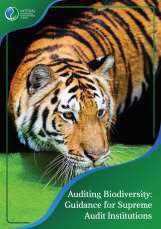
Environmental degradation and habitat loss are growing concerns within the international community. Life on Earth depends on nature, and humans need the diversity of nature for important things such as food and water resources. Nature is also a source of economic opportunities. However, the loss of different species of animals, plants, and microorganisms is accelerating.
This updated document has been developed to help auditors audit biodiversity; educate auditors on the nature of biodiversity and the reason it has to be audited; describe the major role that SAIs can play by auditing their government's actions and reminding them of their commitments; and present case studies to SAIs to help them learn how others have approached this audit topic, which involves large amounts of public funds.
The document has four main sections: an introduction and three chapters.
This project was co-led by the SAIs of Indonesia and Lesotho with the consultation of the Secretariat of Convention Biological Diversity. This project also received support from subcommittee members including the SAIs of Estonia, China, Nigeria, Cameroon, Brazil, and Canada, and the European Court of Auditors.
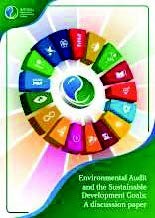
The International Organization of Supreme Audit Institutions (INTOSAI) Strategic Plan for 2017--2022 included SDGs as a cross-cutting priority. In line with the strategic intent of INTOSAI, WGEA's 2017-2019 Work Plan proposed the development of an audit guideline on delivering the 2030 Agenda (Sustainable Development Goals) focusing on environmental auditing. This discussion paper aims to provide important information about the 2030 Agenda and SDGs, as well as examples of audits that have been carried out in this area.
This discussion paper has four main parts.
The first part contains concepts and definitions on sustainable development, the 2030 Agenda, and SDGs to contextualize and support the examples presented throughout this document.
The second part presents how the models of sustainable development have evolved in terms of how the economic, social, and environmental pillars relate to each other and the implications for auditors of defining audit concepts and approaches for environmental auditing. This part also discusses the role of SAIs in the implementation of the SDGs; describes how SAIs can contribute to the achievement of SDGs; and identifies INTOSAI and WGEA frameworks, guides, and projects that can be helpful for auditing the SDGs.
The third part of the discussion paper presents an overview and some examples of how SAIs contribute to the SDGs when undertaking environmental auditing. It reports on specific audits that have been carried out by SAIs to assess the preparedness of national governments to implement the 2030 Agenda and the SDGs. In addition, it presents examples of environmental audits performed by three SAIs that propose models of how to conduct an audit with an SDG perspective. Finally, this part highlights some of the common findings and challenges national governments face in preparing for or implementing the SDGs as well as challenges encountered during the audits. These challenges include funding; developing or adapting institutional frameworks to implement the SDGs across the government; integrating sustainable development and striving for policy coherence; and the gap in the availability and reliability of information and data for implementation and monitoring.
The fourth part of the report poses some of the questions that need to be discussed and agreed upon among SAIs in order for SAIs to best support national governments in tackling their SDG implementation challenges. Among these questions are how to adapt environmental auditing in the broad context of sustainable development and in the specific context of the SDGs. The proposed next steps are to clarify these important concepts with WGEA or other INTOSAI colleagues and to provide clear guidance on auditing the SDGs.
Given the principles, concepts and scope underlying the SDGs, this discussion paper concludes that a whole-of-INTOSAI approach should be taken to determine next steps and answer the questions posed. This paper aims to provide SAIs the best way to fulfil their role and add value to the implementation of SDGs.
The SAIs of Brazil, Canada, and Indonesia volunteered to lead the development of the paper, and SAIs worldwide made contributions. INTOSAI WGEA and its Steering Committee members, INTOSAI Development Initiative (IDI), and UNDESA also provided valuable input and help.
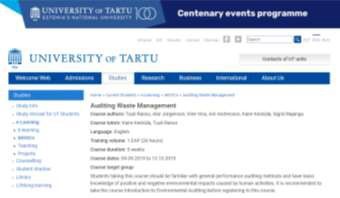
The aim of this course is to introduce the concept of waste and review waste-related topics from the categories of waste and waste-related problems to the principles, policies, and tools used in waste management, as well as the possibilities for auditing waste issues using performance audit methods. The course consists of reading material, video lectures, exercises, tests, and audit cases based on the practice of several SAIs. SAIs from the following countries contributed to developing the MOOC: Brazil, Costa Rica, Croatia, Czech Republic, Estonia, Guatemala, Kuwait, Latvia, Lithuania, Morocco, the Netherlands, Paraguay, Peru, Philippines, Slovakia, and the United States.
After finishing the course, course participants should
SAI of Estonia led the project in cooperation with the University of Tartu, Estonia.
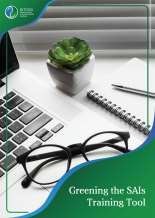
Worldwide, SAIs conduct audit activities with the purpose of contributing to various aspects of sustainability, such as energy, waste, and water management. SAIs themselves are coming under increasing pressure to engage with and respond to climate change and other sustainable development issues, and the associated risks and opportunities. SAIs are not only expected to make commitments towards sustainability but also to take action to understand and reduce the unsustainable environmental impacts of their own organizations and lead by example with their own activities as responsible and transparent institutions.
The aim of the training is to promote integration of the environment and sustainability concerns into SAIs' own internal management and practice in order to make their workplace more environmentally responsible and resource-efficient. The training will include a one-day interactive training session with corresponding materials on greening concepts and measures - in particular, how to introduce greening changes into a SAI.
This training project was led by the European Court of Auditors (ECA) and SAI of Estonia. The training materials are based on the experiences of ECA, SAI of Estonia, and other SAIs in implementing green office principles/environmental management systems. The "Greening SAIs" research paper, completed by WGEA in 2016, and other relevant materials were used.
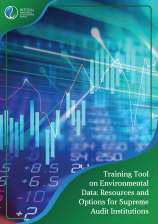
To use this training toolkit, potential participants would need knowledge of computer assisted audit technology (CAATs) and acquaintance with common functions such as data extraction, summarizing, aging, and stratification. This training toolkit includes interactive sessions with materials on these aspects and hands-on exercises using GIS, remote sensing, and CAATs, with illustrative environmental data. The training toolkit has balanced theory, practical examples, and hands-on training based on environmental data in digital form and is aimed at equipping an environmental auditor with the competence to choose and use appropriate data analytic tools.
The training toolkit is divided into four modules:
The SAI of India led the project with support from the SAI of the United States.
The Tunisian Court of Audit hosted the ARABOSAI WGEA Annual Meeting from January 28 to 31, 2019. Twelve representatives from seven SAIs and the regional WGEA Secretariat attended. SAI representatives from Jordan, Egypt, Mauritania, Tunisia, and Kuwait provided an overview of environmental audit results on the effectiveness and efficiency of government authorities on combating desertification.
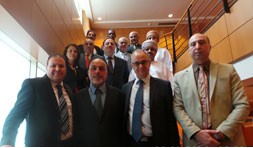
Topics raised about environmental audits on combating desertification included:
Some of the recommendations made in the audit reports on combating desertification include:
By the Chair of ARABOSAI WGEA, State Audit Bureau of Kuwait.
EUROSAI members discuss waste management, circular economy
Nearly 50 participants from 23 European SAIs attended the EUROSAI WGEA Spring Session hosted by the SAI of Cyprus from May 7-8, 2019, in Kalopanayiotis, Cyprus.
The session was dedicated to waste management and circular economyâ€â€the concept of reusing and recycling discarded materials. Waste issues are continually critical for several European countries, and policies related to a circular economy cut across various sectors.
Auditors are well placed to investigate the mechanics of waste management, map the bottlenecks, and help decision-makers work toward achieving a future in which little waste is produced and waste is redirected back into the manufacturing cycle.
Experts from Cyprus and Estonia, as well as from the Flemish Institute for Technological Research (VITO) and EU Network for the Implementation and Enforcement of Environmental Law (IMPEL), provided technical support during the Spring Session.The presentations and discussions demonstrated that little audit work has been conducted in the fields of circular economy and waste prevention and that there is a need for additional audit work. As several countries have yet to achieve their waste management and recycling targets, it is appropriate for their SAIs to investigate their waste management tools and practices. At the end of the seminar, participants brainstormed a list for audits in the waste and circular economy field.
A spirited debate on the role of waste-to-energy in a circular economy, mostly centered on the incineration of waste, resulted in a comprehensive list of supporting and opposing arguments. Participants also discussed potential future cooperative audits on waste management and the circular economy. The Polish SAI's proposal for a plastic waste cooperative project emerged as the most viable and has already attracted the interest of several SAIs; the project will go live in 2020.
A full recap of the Spring Session is available on EUROSAI WGEA's webpage at https://www.eurosaiwgea.org/meetings/Pages/Spring-Session-on-Waste-and-Circular-Economy.aspx.
In 2018, seven EUROSAI WGEA members audited the management of marine protected areas (MPAs) in the Mediterranean Sea and Portuguese Atlantic Coast. The SAIs of Cyprus and Malta led the collaborative project, which was also supported by the SAIs of Albania, France, Greece, Portugal, and Slovenia.
The SAIs reported that while commitment to the protection of MPAs was evident through the increase in the area, the lack of site-specific management plans and regulations, as well as delays in the designation of MPAs within the high seas, remained common issues of concern.
Participating SAIs also identified the potential for strengthening national strategic frameworks and noted that site assessments to designate MPAs were not always appropriately broad. Furthermore, the joint report highlighted weaknesses in administrative capacity and limited coordination among stakeholders as key elements hindering adequate monitoring and enforcement in MPAs. Consequently, there was no assurance that the MPAs were being sustainably managed in a way that protected biodiversity as intended.
The SAIs recommended that national authorities step up their efforts to determine the right balance between conservation and sustainable economic growth in the marine sector.
The press release and full report of the cooperative audit are available at http://www.audit.gov.cy/audit/audit.nsf/All/FB23150DBE2FC378C22584420024CA19?OpenDocument

The Supreme Audit Office of the Czech Republic is honoured to organize the XI EUROSAI Congress, from May 31 through June 4, 2020, in Prague.
The main goal of the Congress is to inspire and motivate participants through discussions and exchange of opinions on the best products of SAIs.
The main vision of the Congress is "3C-3E-3I":
This vision expresses the goal of providing all participants with easily accessible and usable information for their work. Workshops will include new tools and attitudes about audit work shared in a participatory and interactive style with an emphasis on the 3C-3E-3I vision.
Twelve workshops will focus on a range of topics including visualization, international hackathon, tax audits, and the Benchmarking Information Exchange Project. Furthermore, because the SAI of the Czech Republic is a member of WGEA, the need for an environmental workshop is obvious.
The workshop on environmental SDGs will be interactive and full of discussion, active cooperation, and knowledge sharing among SAIs. The purpose of the proposed workshop is to support and strengthen information sharing and to facilitate cooperation between SAIs. It will focus on audits that execute the duties and tasks of individual states for the environmental SDGs. Likewise, the workshop will emphasize the environmental impact of the SAIs' audit activities in the context of the whole of Europe. The main objectives of the workshop on environmental SDGs will be to discuss audit approaches focusing on sustainability issues and the possibility of comparisons of the environmental SDGs among countries.
Information exchange, experienced speakers, market place and much more — that will be XI EUROSAI Congress in Prague!
Visit https://www.eurosai2020.cz/.
For further information, please contact Michal Rampir at michal.rampir@nku.cz or Sylva Müllerová at sylva.mullerova@nku.cz.
 Australia : Audits on extreme weather services and national parks
Australia : Audits on extreme weather services and national parks In July 2019, the Auditor-General for Australia identified the Australian National Audit Office's strategy for 2019-2020 environment and energy audits. Key considerations include the planning and implementation of environmental regulation, the design of grant programs for environmental restoration activities delivered by third parties, and financing arrangements to support reliable and low-emissions energy technology.
For more information on environment and energy audits, see: www.anao.gov.au/work-program/portfolio/environment-and-energy.
The Auditor-General for Australia also recently presented two environmental performance audits to the Australian Parliament:
For further information, please contact Mark Rodrigues at mark.rodrigues@anao.gov.au.
 Czech Republic : Funds earmarked for support of air quality improvement
Czech Republic : Funds earmarked for support of air quality improvementIn January 2019, the Czech Supreme Audit Office (SAO) published a report evaluating the impact of recent measures taken to improve air quality. The objective of the audit was to verify whether the measures specified by the Operational Programme Environment (OPE) and the National Programme Environment (NPE) were effective, as well as examine whether these measures contributed to the improvement of air quality.
The SAO identified significant risks of the failure to meet the objective:
• The strict national emission limits of 2020 will be difficult to meet as regards the reduction of the emissions of fine particulate matter.
• The measures set for air quality improvement are not performed sufficiently and in time.
Also, a total of seven out of the 23 priority measures of the National Emission Reduction Programme (NERP) were not fulfilled before the deadline or before the completion of the audit.
Another six of the 23 priority measures of the NERP are fulfilled on a continuous basis, but there are significant risks of the failure to implement them in time and to the required extent. Particularly the transportation sector measures are not being fulfilled adequately.
The fulfilment of the measures under the Air Quality Improvement Programmes cannot be evaluated sufficiently and conclusively because there is no effective system for the timely collection of data.
There is a risk that the Czech Republic will fail to meet the goal of reducing exposure for fine particulate matter (PM2,5).
The wording of the EU directive is not clear as to what urban background stations the data evaluated should come from. The Czech Hydrometeorological Institute does not have a current policy for the state network for air pollution monitoring. Furthermore, the State Environmental Fund does not monitor and evaluate the economy, efficiency, and effectiveness of the funds used from the NPE for supporting air quality improvements.
With regard to the significant impact of cross-border transmission of air pollution between the Czech Republic and Poland, the ministry should hold transboundary consultations with Poland in the preparation of the national air pollution control programme.
The full report is available at https://www.nku.cz/assets/kon-zavery/k18004_en.pdf. For further information, please contact Benjamín Groll or Sylva Müllerová at sylva.mullerova@nku.cz or benjamin.groll@nku.cz.
 Estonia : Citizens not adequately informed about pesticide levels, health risks in common foods
Estonia : Citizens not adequately informed about pesticide levels, health risks in common foodsFrom 2018 through 2019, the National Audit Office of Estonia (NAOE) evaluated
The NAOE found that test results published by the Veterinary and Food Board and the Ministry of Rural Affairs on pesticide levels in plant-based foods were based on a small number of tests on selected foods and did not fully assess health risks associated with these pesticides. For example, NAOE found some tests did not check for each pesticide in all the foods being tested, leaving consumers with the false impression that all active substances are tested in all the samples despite only partial analyses being conducted.
NAOE concluded that authorities were not fully transparent about their methods and that the tests’ overall results are inadequate for making general conclusions about food safety.
In addition, NAOE found that government food tests analysed a disproportionately large number of organic and locally grown foods, which usually contain less pesticide residues compared to foods typically found in the average Estonian’s shopping basket.
NAOE pointed out that authorities are not giving enough attention to the amounts of pesticide residues consumed by people despite the fact that eating large quantities of residue-containing food could be a significant health risk factor to more vulnerable populations such as unborn children, small children, the chronically ill, and vegans.
The audit also found that the Veterinary and Food Board is not able to remove from sale the quickly perishable fruits and vegetables containing harmful quantities of pesticide residues before people buy them.
The NAOE issued an opinion that responsible authorities should provide considerably more transparent information to consumers about the levels and health risks of pesticides in food, as well as make improvements to the government’s testing methods and food safety monitoring system.
Activities of the state in guaranteeing food safety (English): https://www.riigikontroll.ee/Riigikontrollipublikatsioonid/Auditiaruanded/tabid/206/Audit/2482/Area/63/language/en-US/Default.aspx
 Jordan : Water loss management evaluation in capital governorate
Jordan : Water loss management evaluation in capital governorateThe Audit Bureau of Jordan conducted a performance audit to evaluate the management of drinking water loss in Amman as part of the Bureau’s commitment to implement a cooperative water protection audit with Asian Organization of Supreme Audit Institutions’ (ASOSAI) Working Group on Environmental Auditing (WGEA).
The objective of the audit was to verify the efficiency of the procedures and operations implemented by the Water Authority of Jordan and the Miyahuna Company in reducing drinking water loss in the capital from 2015 through 2018 and to study the operations implemented to limit the illegal uses of and aggressions on the drinking water networks.
The audit found that legislative, regulatory, and technical frameworks must be improved. Based on these findings, the Audit Bureau of Jordan recommended that the Water Authority of Jordan and the Miyahuna Company:
The audit also suggested that, among other actions, the Water Authority of Jordan and Miyahuna Company
The audit also emphasized the importance of coordination between Miyahuna Company and other government entities before implementing infrastructure works.
 Kuwait : Environmental audit on freshwater sustainability
Kuwait : Environmental audit on freshwater sustainabilityThe State Audit Bureau of Kuwait (SAB) conducted an environmental audit to assess the efficiency and effectiveness of the Ministry of Electricity and Water in delivering high-quality, low-cost freshwater to satisfy Kuwait's needs without environmental damage. The audit also assessed ministry efforts in completing freshwater projects and supporting water conservation. This audit mission is in line with U.N. SDG 12, which aims to ensure sustainable consumption and production patterns.
The audit team reviewed the ministry documents, budgets, statistics, relevant sections of the Kuwait National Development Plan, and other scientific resources. Additionally, several meetings were held with personnel in charge of ministry freshwater sector and specialists from scientific and supervisory organizations.
The audit determined that the ministry of electricity and water relies only on desalination and there are no other techniques to deliver other natural sources of freshwater. Additionally, all desalination units are powered by fossil fuels, and no units are powered by renewable energy. Furthermore, the cost of fresh water production in 2016-2017 increased compared to 2015-2016, as fuel costs contribute significantly to the production cost.
The full report will be available on SAB’s webpage at: http://www.sabq8.org. For further information, please contact Mr. Adel Alkout, Director of Performance Audit Department, at adelk@sabq8.org and Eng. Mohammad Alzaabi, Technical Support Department, at mohammadz@sabq8.org
 Morocco : Audit of recovery and regeneration of cork oak forests
Morocco : Audit of recovery and regeneration of cork oak forestsMorocco’s national cork oak forests comprise 15 percent of the world’s cork oak area but have endured a severe reduction in total surface area since 1965.
In 2018, the Court of Accounts conducted a performance audit on the recovery and regeneration of cork oak forests that assessed the causes of forest degradation, regeneration and preservation programs and techniques, monitoring and assessment of these programs, and governance limitations of cork oak woodlands.
The audit found that cork oak forests are losing approximately 250 hectares each year due to the interaction of several factors. For example, overgrazing, which limits the possibility of natural regeneration, is a significant problem accelerating cork oak forest degradation. To reverse the degradation of the national cork oak, the Forestry Administration has launched several regeneration plans and programs since the 1970s, experimented with several technologies, and set a goal of planting 30,000 hectares of cork oak trees by 2027. However, 20 years after setting this goal, the results remain at under half the set target.
The natural regeneration of cork oak has proved difficult to implement, especially in certain regions of the country. Forest managers have resorted to artificial regeneration techniques, but cork oak trees continue to die due to a lack of monitoring and maintenance.
The Forest Administration has tried to involve land use right holders in the regeneration of forests by granting compensation for implementing forest
defence measures but this approach did not gain support from all land use right holders.
Lastly, this audit revealed that the lack of a monitoring and evaluation mechanism of these programs results in an inaccurate view of the state of cork oak forests.
The Court of Accounts’ audit report recommended that the Forest Administration
For further information, please contact mohammed.diyer@courdescomptes.ma and assan.namrani@courdescomptes.ma.
 Rwanda : Audit on environmental protection in agricultural projects
Rwanda : Audit on environmental protection in agricultural projectsIn April 2019, the Office of the Auditor General (OAG) of Rwanda completed an environmental audit to assess protection of the environment during the implementation of agricultural projects.
The audit identified the absence of an annual assessment of agroforestry; a measurement and geo-referencing tool; and a map and research to guide agro-forestation. The audit also noted that some agricultural projects have been implemented without conducting Environmental Impact Assessments.
The OAG recommended that the government
Once these recommendations are implemented, they will help Rwanda achieve one of the targets of U.N. SDG 6: to protect and restore water-related ecosystems, including mountains, forests, wetlands, rivers, aquifers, and lakes.
Rwanda faces significant environmental challenges due to pressures from a growing population on the use of natural resources such as land, water, and other non-renewable resources. This is most evidenced in land degradation, soil erosion, a decline in soil fertility, deforestation, wetland degradation, and a loss of biodiversity.
Despite these shortcomings, Rwanda has made remarkable strides towards environmental conservation and has integrated environmental protection into its growth strategy. The country is putting efforts into restoring the integrity of wetlands, and hazardous activities—such as factories that pollute the environment—are being relocated from wetlands to specified areas.
Rwanda started environmental audits in 2014, issuing two reports on the management of healthcare waste and mining activities. Since then, training and participation of OAG senior staff in environmental audit working group meetings has helped OAG build the capacity of auditors and devote more attention to this area. The office now publishes at least one environmental audit report every year.
For more information please contact the OAG at oag@oag.gov.rw. Audit reports are available on the OAG website at http://www.oag.gov.rw.
 South Africa : Placement of environmental issues and risks in public sector audit methodology processes
South Africa : Placement of environmental issues and risks in public sector audit methodology processes
A current Ph.D. study analyzes trends and preferences on the best placement of environmental issues and risks within the public sector audit methodology processes to enhance public sector environmental accountability, both globally and in South Africa.
As custodians of the environment, governments face many challenges to effective environmental oversight, management, and monitoring. Data on global consumption (The World Counts, 2014) indicate that the planet cannot sustain the ever-increasing demands on natural resources it now faces. In a context of competing priorities between economic, social, and environmental needs, all levels of government have a role in addressing and mitigating the most significant environmental risks and impacts within their mandates, operational activities, and service delivery.
The study asks how SAIs can best advance these ends by assessing and reporting on public sector environmental performance while operating within specific mandates, resource levels, and technical capacities. It draws on global and local literature reviews, a comparative analysis of 2003-2015 INTOSAI WGEA survey results, and survey interviews and questionnaires with internal and external stakeholders of the Auditor-General of South Africa.
Preliminary results indicate that while environmental issues and risks may be better suited within the performance audit methodology processes of countries with effective environmental regulatory regimes, other approaches may work better in those with weaker environmental monitoring and enforcement.
For further information, please contact Eric Smith at erics@agsa.co.za or +27(0)18 294 3301.
 Turkey : Performance audit focuses on flood risk management
Turkey : Performance audit focuses on flood risk managementSAI Turkey is conducting a new environmental audit on flood risk management. Turkey experiences widespread flooding resulting in loss of life and property.
The audit will evaluate whether activities conducted for minimizing flood risks are planned accurately and will assess the effectiveness of these activities within the framework of relevant legislation and organizational structures. The audit focuses on risk reduction activities implemented to minimize possible damages and prevent future floods from turning into major disasters.
The methodology for this audit includes obtaining detailed information on flooding events in Turkey, analyzing the issues surrounding flooding events, and investigating possible reasons for flooding damages. Auditors plan to assess flood risk mitigation activities implemented between 2012 (when basin-based flood management started) and 2019, including
The audit focuses on the following researchable questions:
The expected impact of this audit is to increase the effectiveness of flood risk mitigation activities, thereby minimizing the negative impact of floods.
For further information, please contact Ms. Aysegul Boran, Principal Auditor, at aysegulboran@sayistay.gov.tr.
 United States : Audit of hazardous waste sites and climate change
United States : Audit of hazardous waste sites and climate changeThe U.S. Government Accountability Office (GAO) recently completed an audit of the U.S. Environmental Protection Agency’s (EPA) Superfund program, the principal federal program for addressing contaminated sites. EPA has recorded over 500 contaminants, including arsenic and lead, at these sites. Climate change may make some natural disasters more frequent or more intense, which may damage these sites and potentially release contaminants.
The audit examined
GAO analyzed available federal data; reviewed laws, regulations, and documents; interviewed federal officials and stakeholders; visited three Superfund sites that experienced natural disasters; and compared EPA actions to manage risk to GAO’s six essential elements of enterprise risk management.
GAO found that available federal data on flooding, storm surge, wildfires, and sea level rise suggest that about 60 percent (945 of 1,571) of the sites are located in areas that may be impacted by these potential climate change effects. Although EPA has taken some actions to manage risks to human health and the environment from potential climate change effects at Superfund sites, GAO found that these actions did not meet all of GAO’s essential elements of enterprise risk management.
GAO made several recommendations, including that the Superfund program office provide direction on integrating climate information into site-level decision making to ensure long-term protection of human health and the environment.
The full report, including a link to an interactive map of Superfund Sites and selected potential climate change effects, is available at https://www.gao.gov/products/GAO-20-73.For further information, please contact Barb Patterson at pattersonb@gao.gov .

The INTOSAI Working Group on Environmental Auditing (WGEA) aims to increase the expertise in environmental auditing and to enhance environmental governance with high-quality contribution and visibility by both members of the Working Group and non–member SAIs. Currently the INTOSAI WGEA consists of 86 member countries.
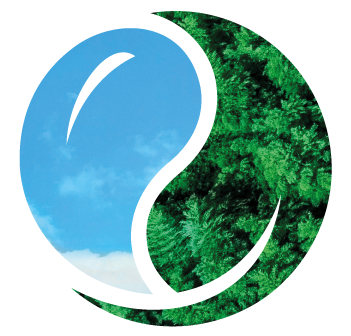
Vivi Niemenmaa - Secretary General
Email: vivi.niemenmaa@vtv.fi
Kati Hirvonen - Project Specialist
Email: kati.hirvonen@vtv.fi
India Roland - International Affairs Planner
Email: india.roland@vtv.fi
Mohamed Ibrahim Jaleel - Environmental Audit Manager
Email: mohamed.jaleel@audit.gov.mv
We collect and process your data on this site to better understand how it is used. We always ask you for consent to do that. You can change your privacy settings here.